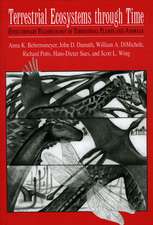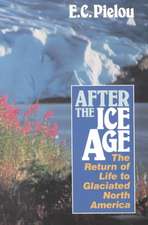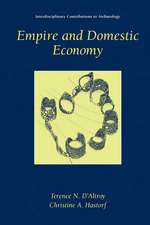Current Paleoethnobotany: Analytical Methods and Cultural Interpretations of Archaeological Plant Remains: Prehistoric Archeology and Ecology series
Editat de Christine A. Hastorf, Virginia S. Popperen Limba Engleză Paperback – 15 ian 1989
Paleoethnobotany offers powerful tools for reconstructing past cultures by examining the interaction of human populations with the plant world. Plant remains from archaeological sites can provide information for a number of disciplines: archaeologists may use such remains to examine how plants were used, how agriculture changed over time, or how plant offerings in burials signaled social status; ecologists and botanists may use them to study morphological changes in plants due to domestication.
Combining case studies and theoretical discussions, Current Paleoethnobotany presents the first full discussion of the major stages and problems of paleoethnobotanical research, from designing and testing equipment, such as flotation machines, to quantification and interpretation. The volume explores a wide range of issues concerning collection techniques, analytical procedures, and interpretive models that will provide accurate information about past human societies from plant remains. The contributors offer data on specific regions as well as more general background information on the basic techniques of paleoethnobotany for the nonspecialist. Throughout, they explicitly examine the assumptions underlying paleoethnobotanical methods and the ways in which those assumptions affect anthropological and ecological research questions.
Based on a symposium presented at the 1985 meeting of the Society for American Archaeology, Current Paleoethnobotany moves beyond a technique-oriented view of paleoethnobotany to successfully integrate current thinking about both procedures and research goals. The contributors demonstrate the potential value of the field of paleoethnobotany and open the way for further discussion and improvement.
Combining case studies and theoretical discussions, Current Paleoethnobotany presents the first full discussion of the major stages and problems of paleoethnobotanical research, from designing and testing equipment, such as flotation machines, to quantification and interpretation. The volume explores a wide range of issues concerning collection techniques, analytical procedures, and interpretive models that will provide accurate information about past human societies from plant remains. The contributors offer data on specific regions as well as more general background information on the basic techniques of paleoethnobotany for the nonspecialist. Throughout, they explicitly examine the assumptions underlying paleoethnobotanical methods and the ways in which those assumptions affect anthropological and ecological research questions.
Based on a symposium presented at the 1985 meeting of the Society for American Archaeology, Current Paleoethnobotany moves beyond a technique-oriented view of paleoethnobotany to successfully integrate current thinking about both procedures and research goals. The contributors demonstrate the potential value of the field of paleoethnobotany and open the way for further discussion and improvement.
Din seria Prehistoric Archeology and Ecology series
-
 Preț: 291.10 lei
Preț: 291.10 lei -
 Preț: 315.80 lei
Preț: 315.80 lei -
 Preț: 259.20 lei
Preț: 259.20 lei -
 Preț: 273.06 lei
Preț: 273.06 lei -
 Preț: 291.69 lei
Preț: 291.69 lei -
 Preț: 319.65 lei
Preț: 319.65 lei - 19%
 Preț: 174.85 lei
Preț: 174.85 lei
Preț: 257.00 lei
Nou
Puncte Express: 386
Preț estimativ în valută:
49.18€ • 51.47$ • 40.93£
49.18€ • 51.47$ • 40.93£
Carte tipărită la comandă
Livrare economică 31 martie-14 aprilie
Preluare comenzi: 021 569.72.76
Specificații
ISBN-13: 9780226318936
ISBN-10: 0226318931
Pagini: 243
Ilustrații: 1 halftone, 3 maps
Dimensiuni: 152 x 229 x 23 mm
Greutate: 0.32 kg
Ediția:1
Editura: University of Chicago Press
Colecția University of Chicago Press
Seria Prehistoric Archeology and Ecology series
ISBN-10: 0226318931
Pagini: 243
Ilustrații: 1 halftone, 3 maps
Dimensiuni: 152 x 229 x 23 mm
Greutate: 0.32 kg
Ediția:1
Editura: University of Chicago Press
Colecția University of Chicago Press
Seria Prehistoric Archeology and Ecology series
Notă biografică
Christine A. Hastorf is associate professor of anthropology at the University of Minnesota. Virginia S. Popper is research collaborator at the Institute of Archaeology at the University of California, Los Angeles.
Cuprins
Series Editors' Preface
1. Introduction
Virginia S. Popper and Christine A. Hastorf
2. Comparability among Recovery Techniques
Gail E. Wagner
3. Flotation Samplings: Problems and Some Solutions, with Examples from the American Southwest
Mollie S. Toll
4. Selecting Quantitative Measurements in Paleoethnobotany
Virginia S. Popper
5. Ratios in Paleoethnobotanical Analysis
Naomi F. Miller
6. Archaeological Plant Remains: Applications to Stratigraphic Analysis
David L. Asch and Nancy Asch Sidell
7. Interpreting the Meaning of Macroremain Abundance: The Impact of Source and Context
Deborah M. Pearsall
8. The Use of Paleoethnobotanical Data in Prehistoric Studies of Crop Production, Processing, and Consumption
Christine A. Hastorf
9. Plant Remains and Culture Change: Are Paleoethnobotanical Data Better Than We Think?
Sissel Johannessen
10. Environmental Interpretation of Archaeological Charcoal
Tristine Lee Smart and Ellen S. Hoffman
11. Possible Statistical Contributions to Paleoethnobotany
Joseph B. Kadane
12. Commentary: Little Things Mean a Lot—Quantification and Qualification in Paleoethnobotany
Richard I. Ford
13. Commentary: Recent Directions in Paleoethnobotanical Research
William H. Marquardt
List of Contributors
Index
1. Introduction
Virginia S. Popper and Christine A. Hastorf
2. Comparability among Recovery Techniques
Gail E. Wagner
3. Flotation Samplings: Problems and Some Solutions, with Examples from the American Southwest
Mollie S. Toll
4. Selecting Quantitative Measurements in Paleoethnobotany
Virginia S. Popper
5. Ratios in Paleoethnobotanical Analysis
Naomi F. Miller
6. Archaeological Plant Remains: Applications to Stratigraphic Analysis
David L. Asch and Nancy Asch Sidell
7. Interpreting the Meaning of Macroremain Abundance: The Impact of Source and Context
Deborah M. Pearsall
8. The Use of Paleoethnobotanical Data in Prehistoric Studies of Crop Production, Processing, and Consumption
Christine A. Hastorf
9. Plant Remains and Culture Change: Are Paleoethnobotanical Data Better Than We Think?
Sissel Johannessen
10. Environmental Interpretation of Archaeological Charcoal
Tristine Lee Smart and Ellen S. Hoffman
11. Possible Statistical Contributions to Paleoethnobotany
Joseph B. Kadane
12. Commentary: Little Things Mean a Lot—Quantification and Qualification in Paleoethnobotany
Richard I. Ford
13. Commentary: Recent Directions in Paleoethnobotanical Research
William H. Marquardt
List of Contributors
Index










